 |
| Taitung's Traditional Meat Preservation Techniques |
|
Taitung is celebrated for its rich natural resources—fertile lands, diverse ecosystems, and abundant marine life. Yet throughout history, its people have faced the unpredictability of natural disasters, including devastating typhoons and earthquakes, as well as intertribal conflicts, waves of immigration, and colonialism. The region's sparse population and remote location have also made it vulnerable to supply disruptions. These conditions paved the way for the emergence of distinctive preservation methods, which have enhanced local flavors over time while reflecting the region’s culture, history, and environment. In this series, we will explore the salting, pickling, fermenting, smoking and drying of staple meat, fish, fruits and vegetables, grains and teas. These processes transformed perishable ingredients into preserved delicacies while telling a broader story about the resilience, resourcefulness and creativity of Taitungers. This edition begins by exploring the preservation of pork, a food deeply connected with Taitung to this very day. BOARS TO BARBEQUES
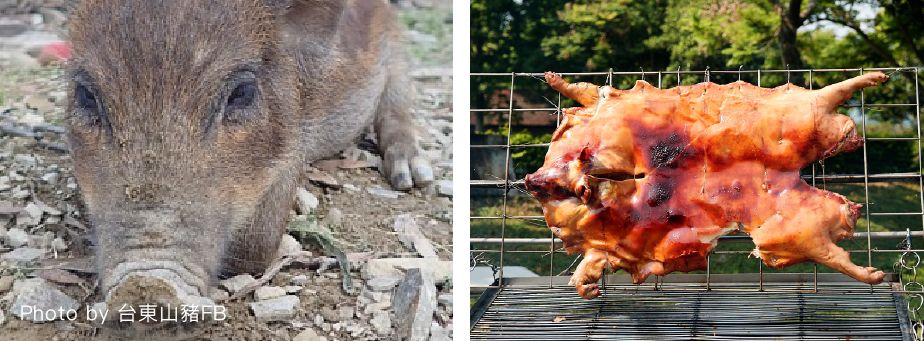 The vast forested mountains of Taitung have always supported plentiful wild boars, and pork has been a cornerstone of local diets for thousands of years. Before domestication of the pig, hunting was an intrinsic part of Indigenous peoples’ identity, culture and survival. Boars were highly valued as they provided significantly more edible meat and fat than the other commonly hunted animals, such as Formosan serows, Reeves’ muntjacs and flying squirrels. Over time, settled farming communities domesticated boars, selectively breeding them to create fatter, more voluptuous pigs. Due to their size and succulence, boars and pigs became the primary meat offerings during Indigenous harvest festivals and, later, Han temple rituals. Their cultural and religious significance endures today and Taitung boasts a thriving contemporary barbeque culture for locals and visitors alike—the aroma of roasted pork permeates through the air at night markets, and open flames flicker as sausages flavored with maqaw mountain pepper and full pig spit-roasts sizzle during Lunar New Year. 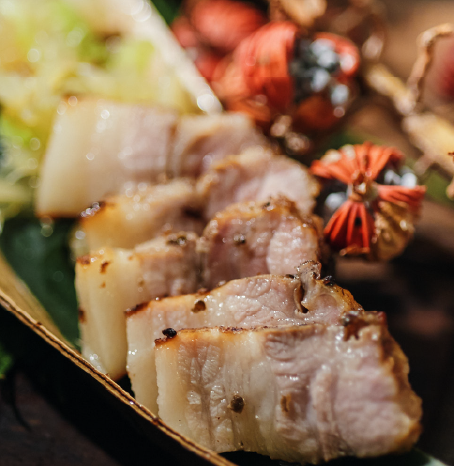 Smoked pork is now an integral part of BBQ culture, featured in innovative local dishes and embraced by foreigners smoking meats for American-style barbecues, like the Pig Out in Donghe. Yet originally, smoking served primarily to preserve meat amidst Taitung’s humidity. While each tribal group had its own methods and rituals for preparing the pork, cold-smoking at low temperatures with hardwoods such as Formosan acacia, guava and crepe myrtle was often favored for preservation, which worked by removing moisture, inhibiting bacterial growth and keeping away flies and insects. PRESERVATION AS RESILIENCE
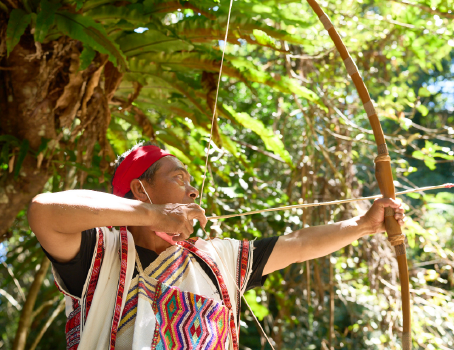 On the east coast of Taitung, the Amis have the saying “The Pacific is our refrigerator,” referring to their easy access to marine protein sources and mineral replenishment. However, landlocked between mountains in the East Rift Valley, hunting was a time and energy-consuming activity, especially before modern traps and firearms, involving intense physical activity and the sweating out of precious electrolytes. Moreover, there were no extensive, secure food supply routes and tribal communities often had to flee their lands during times of war, domination and natural disaster. This dynamic unpredictability naturally intertwined with the local ecology to develop into Indigenous wisdom guiding against waste and overconsumption in favor of sustainable practices and resilience. But what would be done with leftover meat that couldn't be eaten immediately? Before modern refrigeration, how could this precious protein and sodium source be stored? Guided by necessity and creativity, the Indigenous peoples of Taitung mastered the art of preservation to ensure food security, while enhancing their cuisine in the process. SIRAW: THE AMIS ART OF SALT-CURED RAW PORK
 “Siraw” is a form of raw pork marinated and cured in salt by the Amis tribe, which can be fermented for different flavors. While it appears raw, it tastes cooked, albeit chewy, with distinct flavors. The curing process begins by cutting pieces of pork loin or shoulder with the skin, fat and lean meat attached. Coarse salt is massaged thoroughly into the meat to ensure tenderness and full coverage before placing it in a container to allow the water to seep out. The residual water is then boiled, filtered and cooled, before being returned to the container with the meat and some rice wine to ferment over several months. Other ingredients may be added, depending on the individual tribe or family and reflecting the diversity and creativity of Taitung. In the East Rift Valley, rice is often added to encourage lactic acid bacteria, imparting a tangy flavor that cuts through the richness and further tenderizes the meat. The East Coast Amis usually skip the rice, allowing the natural meaty flavor to shine through. Once ready, the cured pork can be eaten raw as a drinking snack or added to various cooked dishes. At some marriages or funerals on the East Coast, the male of the host family slaughters and cuts up a pig to divide among the tribe, from which each family makes their own variation of siraw. A similar food of the Paiwan tribe in southern Taitung is valem, which is salt-cured raw pork fermented with taro powder; it is not eaten raw but instead added to other cooked foods, as a filling in the cinavu millet rice wrap or sweet millet tangyuan at the winter solstice. Local stores in Amis villages display salted raw pork in glass containers alongside similar concoctions using salted river fish and fish eggs or curried pig intestines—any part of the animal's body that is edible—alongside various pickled vegetables, highlighting the wisdom of not letting anything go to waste. Some, like the chef-owner of the HeZuo Friendly Crops (日出禾作) brand, have been creatively adapting siraw into modern dishes, such as flamed siraw sushi or rice dumplings. At the Slow Food Banquet in Chishang this January, Hezuo presented a rice dish with local greens, blood soup and siraw to the attendees. The Chubby Rabbit in Luye, makes a fusion siraw pizza. Another related preparation method and crowd-favorite in Taitung is the salted pork (xian zhu rou 鹹豬肉), which is marinated with other ingredients such as the citrusy maqaw mountain pepper, garlic, prickly ash and other local herbs. THE SOURCES OF SALT
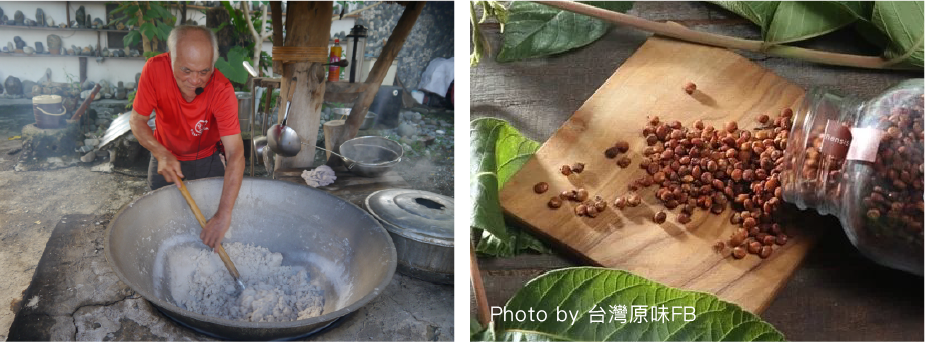 The Pacific was not only a refrigerator for the Indigenous Taitungers, but also an infinite supply of salt for curing meats and vegetables, extracted from the seawater using simple boiling methods that required only clay pots and firewood. Other Indigenous groups who inhabited mountain regions further from the coast, like the Rukai tribe, had an alternative mountain salt source, the dried red sumac berries of the rhus chinensis tree. On long hunting trips through the mountains, to cure their meat bounty, tribesmen could simply cut down a rhus branch and soak the berries in water, allowing the salt to leach out. Older tribe members remember being able to lick the plant to replenish their electrolytes. As Han Chinese migrants began arriving in the 1800s, the mass production of salt through solar evaporation methods reduced the need for these traditional salt extraction methods. However the methods and the unique plant flavors have seen a revival in recent years. For example, the Rukai of Taromak Village, in collaboration with the forestry department and the Taiwan Way condiment company, now produce the brand “Mountain Salt Reserve,” salt harvested and extracted from rhus berries by local villagers, and added to other flavors. THE HAKKA EVOLUTION
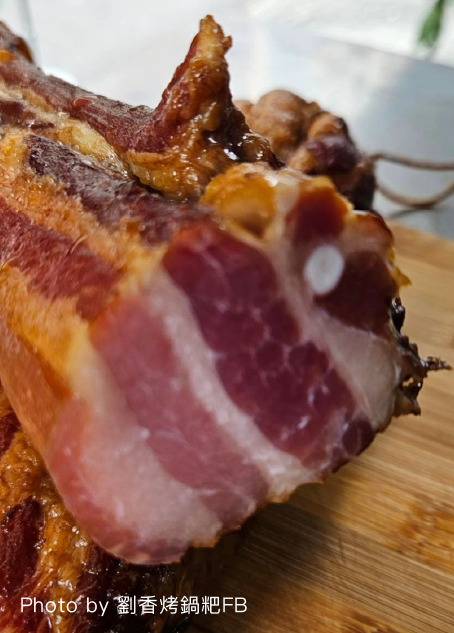 In the 1800s the Hakka communities were among the first Chinese to settle in Taitung, establishing themselves in areas conducive to farming, such as Chishang and Guanshan in the East Rift Valley. They brought with them their cuisine and tailored it to the local climate, conditions and availability of ingredients. While not necessarily conducive to the large-scale pig farming found in southwest Taiwan, the region’s clean, organic conditions are perfect for raising high-quality pigs that often get to roam freely and eat high-quality rice. Given the humidity from the moisture-laden Pacific winds, preservation processes were even more emphasized in Taitung’s Hakka cuisine. For instance, the popular Hakka version of salted pork—cured by rubbing pork belly or collar with a mixture of salt, garlic, five-spice powder, and rice wine—was air-dried or smoked to develop different textures and enhance flavors. Over time, the addition of maqaw mountain pepper, a citrusy spice often used in Indigenous cooking, and other local peppercorns and salts, enriched this preserved delicacy. Other Hakka foods include hard dried bacon (臘肉) and hunter’s sausage (獵腸). After salting they are traditionally air-dried, but in Taitung often smoked to counteract the humidity and take advantage of aromatic local woods to infuse distinct flavors. For their most classic dishes like braised pork belly with preserved greens (酸菜扣肉), the Hakka adapted to experiment with Taitung’s rich diversity of mountain vegetables and greens. This willingness to adapt and innovate to overcome hardships brings us to another important aspect of cuisine in Taitung—the pickling, fermentation and air-drying of vegetables and wild greens, which we delve into in the next issue of Taitung Times. |
| © TAITUNG COUNTY GOVERNMENT 2025 |




